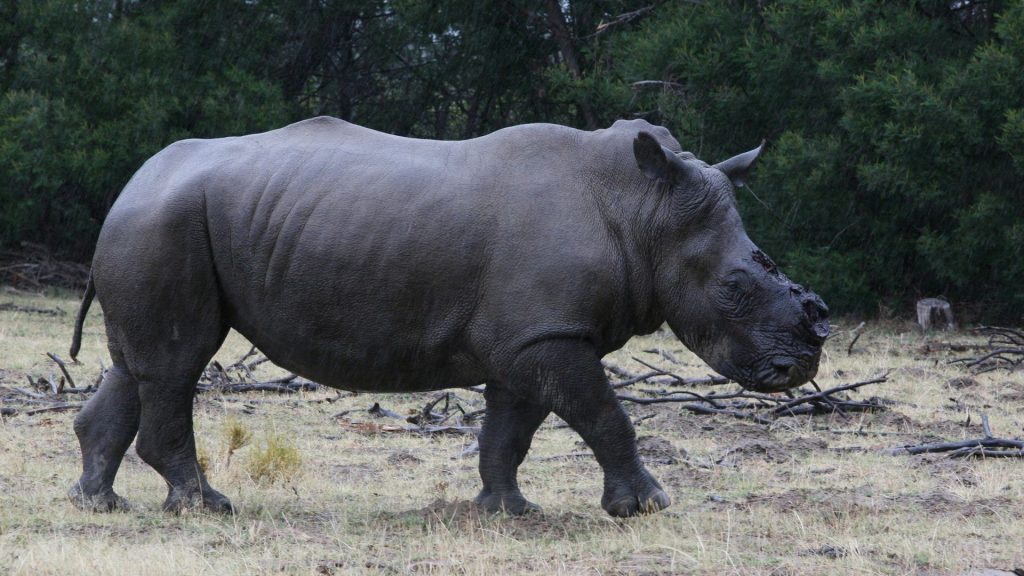How removing rhinos’ horns could save the species: Study

There are five species of rhinoceros in the world, and all of them are the target of poachers. One controversial practice to combat poaching — intentionally removing the animals’ horns — has been in place for decades, but for the first time, data is showing it may be working.
A new study shows that dehorning rhinos reduces poaching by nearly 80%.
Why do poachers target rhinos?
Poachers seek out rhinos specifically for their horns, which are then sold on the black market. Buyers are willing to pay tens of thousands of dollars for these horns.
Unbiased. Straight Facts.TM
500,000 rhinos roamed Africa and Asia at the beginning of the 20th century, but in 1970, rhino numbers dropped to 70,000. Today, only around 27,000 rhinos remain in the wild.

They are commonly used in traditional medicine in Asian countries like China and Vietnam. Horns are falsely believed to treat fever, pain and low sex drive.
How does dehorning work?
For the dehorning process, rhinos are sedated and then given a blindfold and earplugs. Workers then use a power saw to remove the horn.
The process poses a very low risk to the animals and does not harm them.
Impacts of dehorning
A group of scientists, conservationists and government officials spent seven years studying the rhinoceros population in and around Kruger National Park in northern South Africa. The park is home to 25% of the world’s rhinos.
Their study, published Thursday, June 5, in the academic journal “Science,” found dehorning rhinos reduced poaching in game reserves by 78%. It also found no statistical evidence that traditional anti-poaching interventions caused significant reductions in rhino poaching.
Traditional methods cost millions of dollars and include rangers, detection cameras, dog tracking and helicopters.
Deterring but not desisting
While those traditional interventions have been found to be successful in detecting hundreds of poachers, they don’t completely stop the practice from happening.
“Dehorning rhinos to reduce incentives for poaching was found to achieve a 78% reduction in poaching using just 1.2% of the overall rhino protection budget,” said Tim Kuiper of Nelson Mandela University, one of the study’s lead authors. “We might need to rethink our goals. Do we just want to arrest poachers? It doesn’t appear to be making a massive difference to reducing rhino poaching.”
Another issue is that a significant stump of the horn remains even after dehorning. Some poachers still kill rhinos for this section.
Additionally, horns also regrow, so the dehorning process must be repeated every 1 1/2 to 2 years.
Potential for a bigger impact
“Removing their horns — what does it do? Is there any social implications?” Vanessa Duthé, a rhino researcher in South Africa who was not involved in the study, said in an interview with The Associated Press. “Does it change their foraging habits? We don’t really know… so for the social implications, we have seen that removing their horns, at least in black rhinos, cause them to change their spatial movements and to retreat into smaller home ranges.”
There are also concerns that rhinos without their horns show behavioral changes that can impact their ability to establish territories.
The study Duthé pointed at indicated that while poaching rates decreased, dehorned black rhinos became more timid and covered much smaller areas. Researchers believe that the horn is used to establish territories where dehorned rhinos could not.
“It is a big part of what a rhino is, having a horn,” Kuiper said. “So, having to remove it is kind of a necessary evil, if I can put it that way. But it’s very effective. There’s no doubt it saved hundreds of rhinos’ lives.”
Rhino poaching by the numbers
Despite years’ worth of efforts to stop it, rhino poaching remains high in South Africa, with 103 killed in the first three months of 2025. However, those numbers are compared to 2024, when 420 were killed.
According to the World Wildlife Fund, 500,000 rhinos roamed Africa and Asia at the beginning of the 20th century. By 1970, rhino numbers dropped to 70,000 and today, only around 27,000 rhinos remain in the wild.
The WWF said few rhinos survive outside national parks and reserves because of persistent poaching, as well as habitat loss.
Conservation efforts have helped the rhino population. However, of the five species, three remain critically endangered. There are fewer than 70 Javan rhinos, fewer than 200 Sumatran rhinos and just 6,500 black rhinos currently living in the wild.
The greater one-horned rhino is a threatened species, with about 4,000 living in the wild. That population has been increasing with conservation efforts.
And while the white rhino was once thought to be extinct, it is now the most populous species, with around 16,800 living in the wild today. However, they are still considered a near-threatened species.





